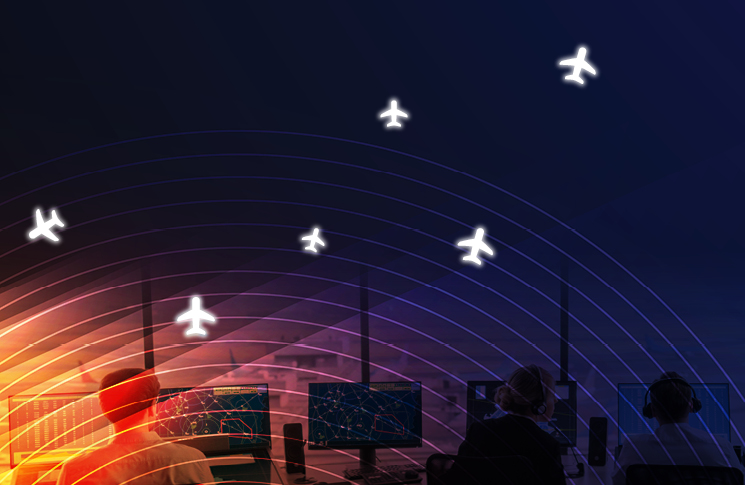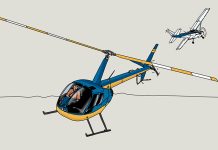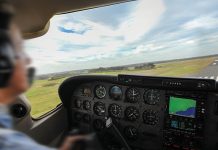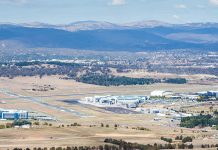In conjunction with the launch of CASA’s pilot safety hub, Kreisha Ballantyne takes a look at flying at controlled aerodromes.
Anyone can sing in the shower, but how will you know if you’re any good if you never take to the stage, or at least to a pub karaoke night?
Flying in controlled airspace is kind of similar; you are in the spotlight before an audience, and your success depends on knowledge, practice and a modicum of natural talent.
While flying in controlled airspace can demand a higher workload, it can also provide a rewarding experience.
Pilots must obtain a clearance from ATC before entering controlled airspace, known as a control area (CTA), or a control zone (CTR) such as a towered aerodrome. These areas and zones are depicted on the VTC, VNC, ERC-low and ERC-high, but are not shown on the WAC.
When you’re flying in controlled airspace, you must continuously monitor the frequency used by ATC, operating as Melbourne Centre, Brisbane Centre or an approach (Darwin Approach) or tower (Hobart Tower) service.
And when you’re operating at a controlled aerodrome you must:
- have an ATC clearance to land, taxi or take-off
- maintain a continuous listening watch on the ATC frequency for the aerodrome
- if you cannot maintain a continuous listening watch, watch for any visual signals from the tower.
Unless you are complying with an ATC clearance or instruction, or flying in accordance with an instrument departure or approach procedure, you must:
- maintain runway track from the take-off until you reach 500 feet AGL unless a change to the track is necessary to avoid terrain
- make all turns in the direction of the circuit pattern when joining the circuit for a landing or when taking off for the purpose of conducting a circuit.
You are responsible for obtaining an airways clearance and, once it has been obtained, you must not change or deviate from your cleared route/track or change level without first obtaining ATC clearance to do so.
Request your airways clearance:
- on the clearance delivery frequency, preferably immediately before starting engines, otherwise as soon as possible thereafter
- if a clearance delivery frequency is not available, use the ground or tower frequency
- before entering controlled airspace.
You must obtain ATC clearance when:
- taxiing on any part of the manoeuvring area
- entering, crossing, or backtracking on a runway
- taking off
- landing.
As well as being divided into controlled or uncontrolled airspace, Australian airspace is further divided into different classes, where internationally agreed rules for visual flight and instrument flying apply. This article will look at Class C and D.
Class C
Class C airspace surrounds major city airports, starting at ground level and stepping up into mid-level Class C or high-level Class A airspace.
The control area steps above Class D aerodromes are also classified Class C, as is airspace within radar coverage south of Sydney between FL125 and FL180. Military restricted airspace at or below FL285 within which a control service is provided, is equivalent to a Class C air traffic service.
IFR and VFR flights are permitted within Class C; VFR flights are limited to 250 kts below 10,000 feet AMSL. ATC services are required to provide separation between IFR to IFR, and IFR to VFR traffic. Traffic information and traffic avoidance advice is provided for VFR to VFR traffic but a separation service is not. Clearance is required by all aircraft operating in Class C.
Jason Moore, a private IFR pilot, flies regularly at Canberra Airport. ‘I consider myself very lucky to operate out of a Class C airport,’ he says. ‘It is, I believe, much more relaxed flying. I know many would not think this but knowing that you always have several eyes watching you and keeping you clear of danger is pretty cool.
‘You are delegating – but never ceding responsibility – decisions about track and altitude; you just have to do what you are told, unless it creates risk, in which case, speak up. The flip side is that you need to recognise you are operating in an environment with air transport and military aircraft that have schedules and huge operating costs, which means you may need to fly around a bit for sequencing, it’s the polite thing to do.
‘The only downside of Canberra being in Class C is that you can’t just go for a bit of a wander over the city but, if first you talk to Tower and Approach, you can achieve most things. If you just want to do a “scenic”, there are approved routes.’
According to Jason, the key to operating in Canberra’s Class C environment is preparation, confidence and knowledge of the formal, and informal, procedures:
- Every flight is going to require submitting a flight plan, unless you stay under 3,500 feet, but you are still going to have to tell the tower about it. Circuits or training area flights do not require to file a plan, but the tower will put a summary plan in the system.
- You always need to know the current ATIS – unless it is outside the tower hours of 06:00 to 23:00, when the AWIS can be received on the VOR frequency.
- GA flying VFR or circuits will be assigned runway 12 or 30 unless specifically requesting another runway.
- GA flying IFR will be assigned 17, 35 or 12 (with an easterly or southerly component you will most likely get 12 to prevent a massive taxi to 17).
- YSCB has formal ground, tower and approach controllers; in quiet times the same controller operates both tower and ground frequencies.
- As with any radio procedure, know what to say, when and where.
Class C procedures will be very familiar to IFR pilots but also, to some extent, those who come from Class D aerodromes.
The flip side is that you need to recognise you are operating in an environment with RPT and military aircraft.
A departure from Canberra will look something like this:
- Submit a flight plan.
- No need for a start clearance.
- On Ground frequency, request ‘airways clearance’ for your route and altitude.
- Complete run-ups (there are no run-up bays like Camden or Bankstown so it’s pretty much anywhere sensible that is not in the manoeuvring area).
- On Ground, request taxi clearance, advise received ATIS and confirm POB.
- Know where you are going – there are many taxiways, and you don’t want to come nose to nose with a 737. Be careful of jet blast as you taxi behind a jet (or even a Dash 8/SAAB) – ailerons into the blast or maintain distance behind. It is real, and powerful.
- Hold short of stop bars! In Canberra the lights control everything as there is often fog on the ground, or over half the aerodrome. Even if the tower controller clears you, do not proceed until the stop bars extinguish.
- Switch over to Tower at the holding point. Advise position and ‘ready’ (when you’re actually ready!).
- When cleared, depart per assigned heading and altitude.
- When told, change to Canberra Approach (yeah, it’s approach even on departure!), advise altitude passing and cleared altitude and, if you have been given one, an assigned heading.
- At some point you will clear the Class C CTA, Approach will hand you to Melbourne Centre (if IFR) and you can continue on your way as per your VFR or IFR plan.
An arrival (and if IFR, an approach) to Canberra will look something like this:
- Have a flight plan filed. If you don’t have one for some reason, Approach can submit one for you, but call well before the Class C boundary and be prepared to be told to do some orbits outside controlled airspace.
- Before you get to the Class C boundary, have the YSCB ATIS.
- If you are flying IFR, you will be handed over to Canberra approach. If flying VFR, then before you get to the boundary (allow at least a few mins for your clearance) contact Approach with position, altitude, ATIS and that you are inbound. Note: VFR flights should plan via the VFR reporting points on the map. From the north, LGGS (Lake George South) is the generally preferred point, from the northwest, Murrumbateman, and from the south, Michelago. Be aware there is a H24 RA2 Restricted area up to 10,000 feet over Tidbinbilla.
- You will be cleared on a track and altitude – from there, just do as you are told.
- For VFR: when you have the airfield in sight, you will be handed over to the Tower; for IFR: you will be handed over at certain predetermined points.
- The Tower will tell you where to fly and clear you to land.
- When you have landed, as you vacate the runway talk to Ground and they will clear you with taxi instructions. If it is not busy, they may tell you where to exit and ‘no requirements on ground’ in which case, taxi to the GA area.
Class D
Class D airspace is used around the non-capital city controlled aerodromes. Protected airspace in the form of Class C steps are provided above Class D to allow high speed and heavy traffic to remain inside controlled airspace while arriving and departing the Class D area.
IFR and VFR flights are permitted within Class D; non-military IFR and VFR aircraft are limited to 250 kts IAS below 10,000 feet AMSL. Traffic information is provided to IFR about VFR traffic and VFR flights receive information about all flights. Clearance is required by all aircraft operating in Class D.
It’s important to remember that your flight does not finish until your engines are shut down.
The principles of operating within Class D airspace are the same at both Metropolitan Class D (Metro D) and Regional Class D aerodromes. Pilots must maintain two-way communications with the relevant ATC tower whenever operating in Class D airspace. For entry into Class D airspace, establishing two-way communications between the aircraft and ATC constitutes a clearance for you to enter the Class D airspace.
Archerfield, Bankstown, Camden, Jandakot, Moorabbin and Parafield are all categorised as Metro D aerodromes.
Bianca Wise is a senior instructor at Flight Training Adelaide in Parafield. In a recent podcast for CASA’s Pilot Safety Hub, she talked about flying in Class D airspace. ‘It’s important to remember that your flight does not finish until your engines are shut down,’ she says.
She offers the following advice to avoid routine errors that occur, particularly in ‘Metro D’ aerodromes, which are often training hubs:
- Assumption is the mother of mistakes: be aware of regular changes such as runway or taxiway directions, which can occur throughout the day.
- Treat all runways as active at all times.
- Be aware of ground ops, such as refuellers and follow-me cars.
- Be aware of rotary activity.
- Never, ever be afraid to ask ATC. If you don’t understand something, or are not clear, ask ATC to repeat.
- If you’re unfamiliar with an aerodrome, call the tower ahead of your flight to ask about local procedures and contact them again with your inbound call, alerting them to the fact you’re ‘unfamiliar with the area’.
- Be sure to make a detailed study of the aerodrome page in ERSA and remember that the VFRG and Airservices’ aerodrome charts are invaluable resources.
- As every Class D is different, read the special procedures in ERSA.
With the higher workload of flying in CTA, the keys to a successful flight are planning, organisation and situational awareness. Knowledge is confidence.
See the Pilot safety hub for resources: casa.gov.au/pilots
The keys to a successful flight are planning, organisation and situational awareness.






As a North American GA pilot, I was a bit confused by the following:
“Pilots must obtain a clearance from ATC before entering controlled airspace, known as a control area (CTA), or a control zone (CTR) such as a towered aerodrome. These areas and zones are depicted on the VTC, VNC, ERC-low and ERC-high, but are not shown on the WAC.
When you’re flying in controlled airspace, you must continuously monitor the frequency used by ATC, operating as Melbourne Centre, Brisbane Centre or an approach (Darwin Approach) or tower (Hobart Tower) service.”
In Canada and the United States, our controlled airspace categories are Class A, B, C, D and E. The way I think of it is that the term “controlled airspace” means that IFR aircraft are controlled by ATC, but VFR – not necessarily. In Canada and the United States, VFR aircraft operating in Class E (a class of controlled) airspace are not subject to an air traffic control clearance and are not required to contact ATC.
I am wondering if this is different in Australia? I see that the article discusses Class C and Class D airspace. Does Australia not have Class E airspace or, if you do, are VFR aircraft required to contact ATC in Class E airspace and operate subject to a clearance?
Thanks for all the great articles. I love reading Flight Safety Australia articles and it is wonderful to know that there is such a vibrant GA scene in the Southern Hemisphere.